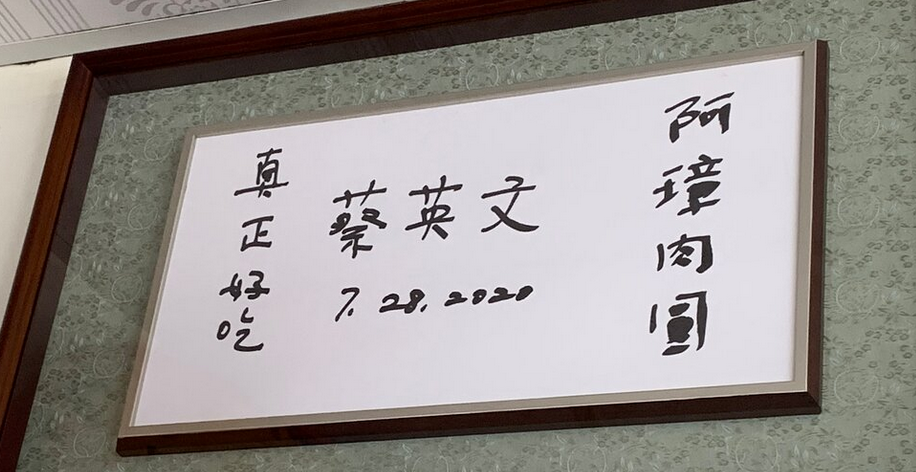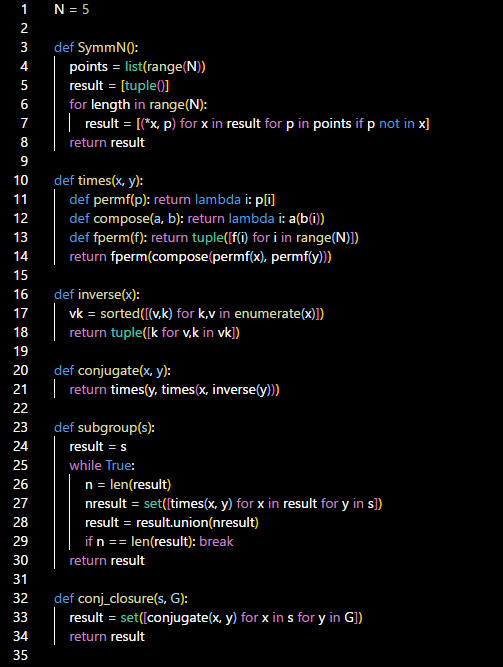谢解释。TheMatrix 写了: 2022年 12月 25日 15:06 这里用了点symmetric group的知识。Symmetric group就是permutation (function)on N objects。写出来就是
Computer algebra 来了
版主: verdelite, TheMatrix
-
mitbbsnew
- 论坛元老

mitbbsnew 的博客 - 帖子互动: 276
- 帖子: 18123
- 注册时间: 2022年 7月 22日 13:15
Re: Computer algebra 来了
Re: Computer algebra 来了
老哥你别再用这色调了可以吗YWY 写了: 2022年 12月 24日 21:07 There are only 3 conjugacy classes in A_5, one containing identity (only), one containing (1 2)(3 4), while the other containing (1 2 3). Here we write a permutation as a product of disjoint cycles.
The conjugacy class containing (1 2) and the class containing (1 2 3)(4 5) all consist of odd permutations. So yes, there are altogether 5 conjugacy classes in S_5.
For some silly reason, I missed the conjugacy class of (1 2 3 4), which is odd, and the class of (1 2 3 4 5), which is even. So, in S_5, there are 7 conjugacy classes, of which 4 classes are even.
根本看不见

Re: Computer algebra 来了
第一个SymmN(),我怎么吐出来这个结果?TheMatrix 写了: 2022年 12月 25日 15:06 这里用了点symmetric group的知识。Symmetric group就是permutation (function)on N objects。写出来就是
(0,1,2,3,4) - 单位元
(3,2,0,1,4) - 看成函数的话就是 (0->3, 1->2, 2->0, 3->1, 4->4)
这样的。共有N!个。可以相乘 - 就是函数的合成, 构成了群。
第一个函数 SymmN,就是写出N个元素的全部permutation。这个小问题放在LeetCode上,肯定不是easy的,至少是medium的。
第二个函数 times,就是permutation的乘法,也就是函数的合成。这在LeetCode上应该也是medium的。
第三个函数 inverse,就是一个permutation的inverse。这也得是medium的。
第四个函数conjugate,就是乘法 hgh-1。用乘法函数就简单了。
第五个函数 subgroup,是一个permutation的集合生成的子群,也就是以集合中元素各种乘法张成的子群。这个在LeetCode里应该是hard。
最后一个函数 conj_closure,是一个子集在全集中的全部conjugate。
代码: 全选
[(0,), (1,), (2,), (3,), (4,)]-
TheMatrix楼主

- 论坛支柱

2024年度优秀版主
TheMatrix 的博客 - 帖子互动: 277
- 帖子: 13638
- 注册时间: 2022年 7月 26日 00:35
Re: Computer algebra 来了
不应该啊。你是不是漏一行代码?
代码: 全选
N = 4
def SymmN():
points = list(range(N))
result = [tuple()]
for length in range(N):
result = [(*x, p) for x in result for p in points if p not in x]
return result
Re: Computer algebra 来了
我用highlight的本意是让被高光的文字更显眼,没想到你选的个人的偏好是ne-blackground。。。
持仓抄底锁利,你钱你定
看牛观猪喊熊,自娱自乐
股市变幻莫测,不作不死
赌途曲折无常,吃枣药丸
看牛观猪喊熊,自娱自乐
股市变幻莫测,不作不死
赌途曲折无常,吃枣药丸
Re: Computer algebra 来了
关于S_n的共轭类,我个人觉得用disjoint cycle的形式更简洁(也更简单),比如我们看S_6, the group of permutations on {1, 2, 3, 4, 5, 6}:
The conjugacy classes of S_6 are as follows:
Some may ask: how to list all permutations in a conjugacy class, say the conjugacy class of (1 2 3)(4 5)? The answer is that it consists of all permutations in S_6 that can be written as a product of two disjoint cycles of lengths 3 and 2 respectively, such as (1 3 2)(5 6), (2 5 4)(1 3), etc..
但愿没漏掉什么共轭类。。。总之我就是提个思路。。。大家应该已经看到了规律。
The conjugacy classes of S_6 are as follows:
- the conjugacy class containing the identity (only), which is even
- the conjugacy class containing (1 2), which is odd
- the conjugacy class containing (1 2)(3 4), which is even
- the conjugacy class containing (1 2)(3 4)(5 6), which is odd
- the conjugacy class containing (1 2 3), which is even
- the conjugacy class containing (1 2 3)(4 5), which is odd
- the conjugacy class containing (1 2 3)(4 5 6), which is even
- the conjugacy class containing (1 2 3 4), which is odd
- the conjugacy class containing (1 2 3 4)(5 6), which is even
- the conjugacy class containing (1 2 3 4 5), which is even
- the conjugacy class containing (1 2 3 4 5 6), which is odd
Some may ask: how to list all permutations in a conjugacy class, say the conjugacy class of (1 2 3)(4 5)? The answer is that it consists of all permutations in S_6 that can be written as a product of two disjoint cycles of lengths 3 and 2 respectively, such as (1 3 2)(5 6), (2 5 4)(1 3), etc..
但愿没漏掉什么共轭类。。。总之我就是提个思路。。。大家应该已经看到了规律。
持仓抄底锁利,你钱你定
看牛观猪喊熊,自娱自乐
股市变幻莫测,不作不死
赌途曲折无常,吃枣药丸
看牛观猪喊熊,自娱自乐
股市变幻莫测,不作不死
赌途曲折无常,吃枣药丸
-
TheMatrix楼主

- 论坛支柱

2024年度优秀版主
TheMatrix 的博客 - 帖子互动: 277
- 帖子: 13638
- 注册时间: 2022年 7月 26日 00:35
Re: Computer algebra 来了
嗯。而且disjoint cycle type不分顺序,比如YWY 写了: 2022年 12月 26日 13:35 关于S_n的共轭类,我个人觉得用disjoint cycle的形式更简洁(也更简单),比如我们看S_6, the group of permutations on {1, 2, 3, 4, 5, 6}:
The conjugacy classes of S_6 are as follows:
Now, if you are given a permutation in S_6, say (4 2 5)(3 6), how do you know which conjugacy class it belongs to? The answer is that (4 2 5)(3 6) belongs to the conjugacy class of (1 2 3)(4 5).
- the conjugacy class containing the identity (only), which is even
- the conjugacy class containing (1 2), which is odd
- the conjugacy class containing (1 2)(3 4), which is even
- the conjugacy class containing (1 2)(3 4)(5 6), which is odd
- the conjugacy class containing (1 2 3), which is even
- the conjugacy class containing (1 2 3)(4 5), which is odd
- the conjugacy class containing (1 2 3)(4 5 6), which is even
- the conjugacy class containing (1 2 3 4), which is odd
- the conjugacy class containing (1 2 3 4)(5 6), which is even
- the conjugacy class containing (1 2 3 4 5), which is even
- the conjugacy class containing (1 2 3 4 5 6), which is odd
Some may ask: how to list all permutations in a conjugacy class, say the conjugacy class of (1 2 3)(4 5)? The answer is that it consists of all permutations in S_6 that can be written as a product of two disjoint cycles of lengths 3 and 2 respectively, such as (1 3 2)(5 6), (2 5 4)(1 3), etc..
但愿没漏掉什么共轭类。。。总之我就是提个思路。。。大家应该已经看到了规律。
(1 2 3 4)(5 6)
(1 2)(3 4 5 6)
算同一个type?
Re: Computer algebra 来了
对,这两个是共轭的,可以通过 1->3, 2->4, 3->5, 4->6, 5->1, 6->2来实现(就是用这个置换做共轭)。TheMatrix 写了: 2022年 12月 26日 13:53 嗯。而且disjoint cycle type不分顺序,比如
(1 2 3 4)(5 6)
(1 2)(3 4 5 6)
算同一个type?
持仓抄底锁利,你钱你定
看牛观猪喊熊,自娱自乐
股市变幻莫测,不作不死
赌途曲折无常,吃枣药丸
看牛观猪喊熊,自娱自乐
股市变幻莫测,不作不死
赌途曲折无常,吃枣药丸
-
TheMatrix楼主

- 论坛支柱

2024年度优秀版主
TheMatrix 的博客 - 帖子互动: 277
- 帖子: 13638
- 注册时间: 2022年 7月 26日 00:35

